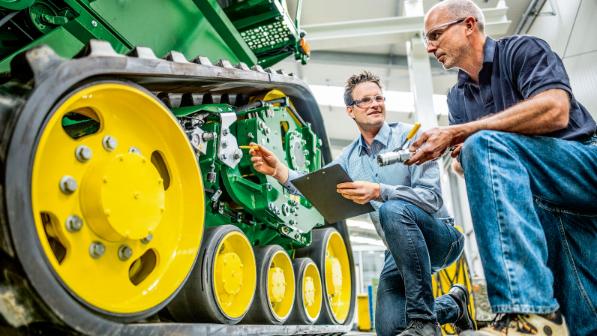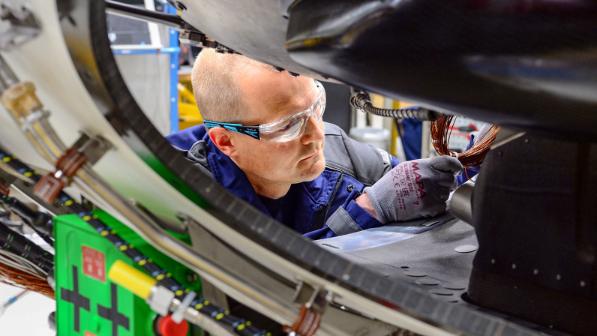The traditional image of the engineering, manufacturing and energy industries is one of machines. In photographs of windfarms, chemical plants or mining machines, the human presence may be limited to a few tiny figures, included mainly to help the viewer understand the awesome scale of the hardware around them. Factories celebrate lines of robots and “lights out” automated production. The view that puts assets before people runs deep in many engineering-heavy sectors. Equipment is designed to achieve specific, quantified performance criteria, and companies like to talk about the capabilities of their products in terms of hard numbers. Where people interact with industrial equipment, there is an expectation that they will be skilled, trained and willing to adapt to the needs of the machines they use.
Bringing the customer into the foreground
Today, engineering and manufacturing companies are shifting their focus significantly: zooming in on the needs of their customers and end users. That change is forcing a wide-ranging transformation of products, organizations and business models.
According to a report by management consultancy Comotion and recruitment agency Talecco, the number of businesses in the U.K. that appointed a chief customer officer or equivalent role increased by 88% between 2017 and 2018. In 2017, only 15% of those appointments were made by companies operating in business-to-business (B2B) markets. The following year, that fraction had increased to 42%.
What’s driving the move? Part of the story is one of changing customer expectations. For the giant internet companies that have disrupted so many consumer-facing industries in recent years, superior convenience and personalization are key competitive weapons. Their influence has shifted the goal posts for customer experience in every sector of the economy.
B2B companies also have plenty of room for improvement. According to McKinsey & Company, most consumer-facing companies achieve scores of 65% to 85% in an index of overall customer experience. The average in the B2B sector is less than 50%.
Engineering and manufacturing companies are also recognizing that the performance of their products is intimately linked to the customer experience. Advanced connectivity is becoming a standard feature of many industrial products today, with onboard sensors providing a wealth of data on machine healthand performance. For the users, however, that data only has real value if they use it to inform operations and decision-making.
In a 2019 survey of the global construction industry, transport telematics company Teletrac Navman found that, while 90% of respondents used telematics technologies, the overwhelming majority used only the most basic features of their systems, such as information on asset location. The underutilized capabilities included features for monitoring fuel use, driver behavior and adherence to maintenance schedules, all of which could lead to significant cost savings and productivity improvements.
Getting users to engage with the more advanced features of industrial products is as much a human problem as a technological one. Working practices need to change to take advantage of new equipment capabilities. Data needs to be accessible and easy to interpret. Creating products and services that do those things well requires companies to really understand how their customers work in real-world conditions in order to provide the analytical capabilities to turn raw data into actionable information, and present that information in a clear, visual way.

Achieving those objectives often requires a collaborative approach. Aircraft-maker Airbus, for example, has partnered with U.S. data analytics specialist Palantir Technologies to develop a data platform it calls Skywise. The system collects up to 24,000 data parameters from participating aircraft, along with relevant maintenance and operational data added by airlines, and uses Palantir’s big data crunching technology to provide users with new insights into the performance and reliability of their fleets. By March 2019, more than 5,000 aircraft from over 60 airlines were connected to the platform. Airbus has pursued an open data approach to the system to encourage uptake and innovation; participating airlines can use the basic features of the platform free of charge, or choose to buy a range of more advanced analytical services from Airbus or from a number of partner organizations.
Building bridges to customers
The development of more customer-centric approaches presents some challenges for industrial companies that their consumer-facing counterparts don’t share. In particular, an engineered product may touch multiple customers and different types of users. A consumer product is typically used by the person who buys it, or maybe a close family member. In industrial markets, the teams of people who specify, purchase, install and operate products may each have their own set of needs and preferences.
Smart products and digital links are helping to bridge the gap between industrial equipment manufacturers and their many end users, offering richer data on product performance and operating conditions. Data doesn’t provide all the answers, however, and industrial companies are pursuing a range of other methods to capture insights and preferences from more stakeholders. Customer advisory boards, for example, provide a way to solicit feedback and test ideas against a group of known and trusted customer representatives. Other companies use digital collaboration platforms such as Slack to collect and disseminate customer insights from across the organization.
Sales and product support activities in engineering-heavy markets can be complex, too. While some industrial companies are making tentative forays into e-commerce and direct sales, many still rely on networks of dealers to handle end customer relationships, leaving them with little direct contact with the ultimate user of the product.
As dealers stand at the frontline of customer experience, they are a key focus of efforts to improve service offerings and strengthen relationships between customer and brand. Agricultural equipment-maker John Deere, for example, is equipping its dealers with the technology and skills to conduct remote diagnostics and troubleshooting of customer machines. The dealers use software tools and knowledge databases that are continually updated with the latest product information from HQ. If they identify any issues that can’t be fixed by remote intervention, the system ensures they can travel to the customer’s location with the right parts and tools to fix the problem in one visit.
From features to service
Sometimes, becoming more customer-centric means admitting that your customers aren’t as interested in your products as you are. The realization that their customers wanted thrust, not jet engines, helped Rolls-Royce to develop its extremely successful “power-by-the-hour” leasing model. The same idea is now gaining traction across the industrial sector. German air-compressor manufacturer BOGE, for example, uses Industry 4.0 technologies to monitor and analyze the performance of its products at customer sites. The company will use that data to design optimized parts and system configurations matched to the user’s specific needs. Upgrades are made at no upfront cost, with the customer agreeing to pay a share of the resulting reduction in energy costs.

Commodity options
What about markets where producers have limited opportunity to tailor their products to meet customer needs? Customer-centricity is even beginning to change the supply of commodities such as bulk chemicals or energy. In these industries, companies are increasingly realizing that some customers are more profitable than others, and that adopting a collaborative approach to things like shipment planning can benefit both sides of the agreement. According to consultancy Bain, picking the right customers and serving them in the right way has the potential to deliver double-digit profit increases for chemical companies.
Even the ultimate commodity – energy – is being drawn into the customer-centric revolution. As they make their plans for the low-carbon energy transition, for example, major oil and gas companies are moving into the electricity generation and supply business. That creates new opportunities for providers to offer bundles of energy services, such as electricity, gas and access to electric vehicle charging networks, to businesses and consumers.
The changing nature of electricity networks is also driving closer and more collaborative relationships between energy suppliers and users. A large industrial electricity user is increasingly likely to have some on-site power generation capacity – from solar arrays on rooftops to backup generators or battery storage. They can sell surplus capacity from that equipment back to the grid in order to reduce their bills or help to meet peaks in local demand.

Energy companies may also pay their customers to reduce consumption at peak times, a strategy known as “demand-side response” that can be more cost effective than building and maintaining expensive standby generating capacity. As the percentage of power coming from intermittent renewable sources goes up, such collaborative agreements with customers will become a vital part of the industry’s overall approach.
Why go looking for the latest logistics stories and insights when you can have them delivered right to you?
The customer-centric supply chain
The new focus on customers is also having an impact on supply chains, especially the downstream logistics processes involved in delivering products to end users. “Logistics is an important touchpoint between an engineering or manufacturing company and its customers,” says Eric Gantier, Engineering, Manufacturing and Energy Sector President at DHL. “That provides opportunities for companies to differentiate themselves from their competitors through superior service or greater flexibility.” Delivering large, complex and delicate industrial products is challenging from a logistics perspective, he notes, which leaves plenty of room for companies to make a good – or poor – impression. “From the type of packaging used to the information shared, customers can see very clearly whether the delivery experience is a priority for their suppliers or an afterthought.”
Companies can also use logistics as a way to provide significant additional value to their customers, says Gantier. “Consider a product such as an elevator, with multiple components that have to be installed in a specific sequence as part of a much larger constructionproject,” he explains. “If the manufacturer can deliver each of those components at precisely the right time, that helps the customer keep their project on track, without the costs and risks involved in storing high-value parts on site.”
The potential impact of logistics on the engineering and manufacturing sector customer experience goes beyond the initial delivery of a product. Aftermarket supply of parts is a significant source of revenues for many engineering companies, and a key element of their overall customer offering, notes Gantier. And as manufacturers and their end customers strive to meet challenging environmental and sustainability goals, the carbon footprint of logistics operations is coming under increasing scrutiny. “In the energy and manufacturing sector, our customers are already asking for low-carbon logistics solutions as a matter of course,” he says. “And we are seeing a rapid increase in interest in the topic from all other industries, too.” — Jonathan Ward
Published: January 2020
Images: Alexander Ehhalt/Deere & Company; iStock






